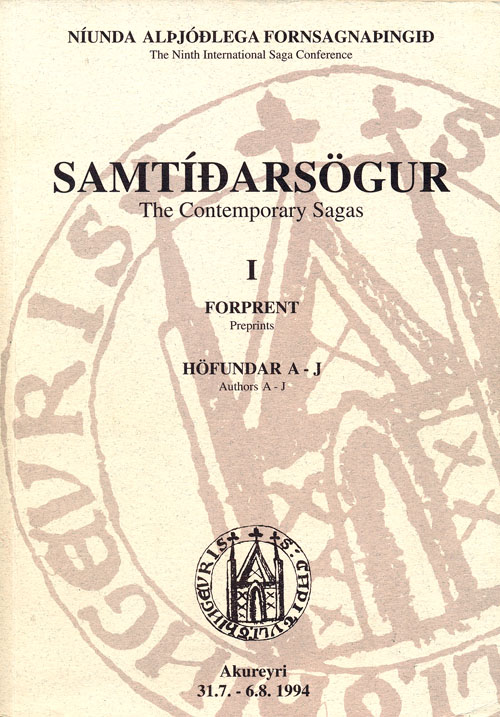Samtíðarsögur / The Contemporary Sagas: Höfundar / Preprints, I-II, ed. Sverrir Tómasson (Reykjavík: Stofnun Árna Magnússonar, 1994).
- Adolf Friðriksson: Sturlunga minjar.
- T. M. Andersson: The literary prehistory of Eyjafjǫrðr.
- Ármann Jakobsson: Nokkur orð um hugmyndir Íslendinga um konungsvald fyrir 1262.
- Patricia A. Baer: The folk tale perspective and political reality in Hranfkels saga.
- Sverre Bagge: Strategy and tactics in the Contemporary sagas: The battle og Fimreite.
- Baldur Hafstað: Af Gísl Illugasyni.
- Graham Barwell and John Kennedy: Bishop Charles Vann Pilcher and the Christian poetry of medieval Iceland.
- Heinrich Beck: Þiðreks saga als Gegenwartsdichtung?
- Alan J. Berger: Law in Njáls saga.
- Bergljót S. Kristjánsdóttir:
…ekki ætlaða ek at þat væri mín yfirseta …
: Vangaveltur um vísur og vinnubrögð sagnaritara í Hákonar sögu.
- Régis Boyer: Were the Icelanders good Christians, according to Samtíðarsögur?
- Lois Bragg: Disfigurement, disability and dis-integration in Sturlunga saga.
- Agneta Breisch: Frid och fredlöshet.
- G. Brugnoli, C. Santini and F. Stok: Victor Hugo as a reader of the Edda:
Han d’Islande
.
- Jesse L. Byock: State and statelessness in early Iceland.
- Ivan Chekalov: Macbeth and Sverrir.
- George Clark: Hallgerðr Höskuldsdóttir: Her domestic economy and the realization of her mixed moral nature.
- Margaret Clunies Ross: Myth and society in Íslendinga saga.
- Margaret Cormack: Women and gender in the sagas of Icelandic saints.
- Kari Ellen Gade:
1236: Órœkia meiddr ok heill gerr
.
- Richard Gaskins: Images of social disorder in Sturla Þórðarsons’s Íslendinga saga.
- Gísli Sigurðsson: Ólafur Þórðarson hvítaskáld og munnleg kvæðahefð á Vesturlandi um miðja 13. öld: Vitnisburður vísnadæmanna í 3. málfræðiritgerðinni.
- Galina Glazyrina: Vikings in a pagan temple in Bjarmaland: The development of a motif in Old Norse sagas.
- Guðrun Ingólfsdóttir:
Þar ber eg litla hugsan fyrir
: Konan, forsjónin og karlinn í Haukdæla þætti.
- Guðrun Nordal: Animal imagery in Íslendinga saga: The wolf and the fall of Sturla Sighvatsson.
- Terry Gunnell: Grýla, Grýlur, Grøleks and Skeklers: Folk drama in the North Atlantic in the early Middle Ages?
- Elena. A. Gurevich: The system of kennings.
- Jan Ragnar Hagland: Ingimundr prestr Þorgeirsson and Icelandic runic literacy in the 12th century.
- Peter Hallberg: Bergr Sokkason and religious Icelandic literature.
- Andrew Hamer: Moralised translation in Strengleikar.
- Haraldur Ólafsson: Eru Íslendingasögur mannfræðilegar heimildir?
- Fredrik J. Heinemann: The post-scenic element in Icelandic saga.
- Helgi Þorláksson: Þjóðleið hjá Brekku og Bakka: Um leiðir og völd i Öxnadal við lok þjóðveldis.
- Inga Huld Hákonardóttir: Hugleiðingar um kvenmyndir í Sturlungu og Danmerkursögu (Gesta Danorum) Saxa.
- Tatjana N. Jackson: Russian-Norwegian relations in the middle og the 13th century as depicted by Hákonar saga gamla Hákonarsonar.
- Judith Jesch: Negotiating traditions: Recent history in Orkneyinga saga.
- Jenny Jochens: Snorris kvinder.
- Peter A. Jorgensen: Four literary styles in three centuries: The Old Icelandic Theophilus legend.
- Jón Karl Helgason: On Danish borders: Icelandic sagas in German occupied Denmark.
- Jón Viðar Sigurðsson: Utenlandske kvinnhelgener på Island i høymiddelalderen.
- Marianne Kalinke: Augustinus saga: A learned and a popular version.
- Simas Karaliūnas: The information on the Aistians in Ólafs saga Tryggvasonar and its importance for the history of the east Baltic region.
- James E. Knirk: The genetic relationship between the two versions of Bǫglunga sǫgur.
- Henry Kratz: Þorlákr’s miracles.
- Riti Kroesen: Ambiguity in the relationship between heroes and giants.
- Hans Kuhn: The emergence of a saint’s cult as witnessed by the Jarteinabækr Þorláks byskups.
- Carolyne Larrington: Gender and genre: Politics, texts and Rannveigar leizla.
- Rikke Malmros: Det sene hedenskabs samfundsideologi: Kan en historiker bruge hedenske fyrstekvad?
- Edith Marold: Vom Umgang mit Feinden.
- John Stanley Martin: The function of bishops in the early Icelandic church.
- Inna G. Matiushina: Rhyme and alliteration in skaldic and Eddic verse.
- Rory McTurk: The supernatural in Sturlunga (summary).
- Lotte Motz: The magician and his craft.
- Britt-Mari Näsström: En nordisk Tannhäuser.
- Gudlaug Nedrelid: Gizurr Þorvaldsson — Miskjend helt, eller største skurken i islandsk historie?
- Orri Vésteinsson: Skjalagerð og sagnaritum.
- Ólafía Einarsdóttir: Om samtidssagaens kildeværdi belyst ved Hákonar saga Hákonarsonar.
- Diego Poli: Why the name Iceland?
- Judy Quinn: Contemporary poetics: Theorizing traditional versification in the Sturlung age.
- Giovanna Salvucci: Sturlunga saga: An essential source for a thanatological approach to the Middle Ages.
- Hubert Seelow: Der Geirmundar þáttr heljarskinns in der Sturlunga saga.
- Inge Skovgaard-Petersen: Sturla Þórðarsons fristat.
- Ulrike Sprenger: Die Darstellung des Vorspiels und des Gottesurteils selbst in der Hákonarsaga Hákonarsonar von Sturla Þórðarson.
- Sveinbjörn Rafnsson: Merlínusspá í sögulegu samhengi — Fáein drög til sögulegrar gagnrýni.
- Marvin Taylor: On Gizurr Þorvaldsson’s speaking style.
- Torfi H. Tulinius: The purloined shield; or Egils saga Skalla-Grímssonar as a Contemporary saga.
- Stephen N. Tranter: Monster-episodes in Grettis saga: A case of reoralization?
- Úlfar Bragason:
Ok þó kunna menn at telja ættir sínar til Hrómundar Gripssonar
: Sagnaskemmtun á Reykhólum og Sturlunguhöfundur.
- Vésteinn Ólason: The political element in Íslendinga saga (summary).
- Viðar Hreinsson: Frásagnaraðferð Sturlu sögu.
- Leonie Viljoen: The British text of Svínfellinga saga — Bad copy or creative compilation?
- Andrew Wawn:
Brass-brained rivalries
: The birth and death of Sturlunga saga in Victorian Britain.
- Diana Whaley: Miracles in the Biskupa sögur: Icelandic variations on an international theme.
- Kirsten Wolf: The cult of Saint Anne in Iceland.
- Stephanie Würth: Thomas Becket: Ein literarisches und politisches Modell für die islandische Kirche im 13. Jahrhundert.
- Anton Zimmerling: The text-building functions of names and nicknames in Sverris saga and Bǫglunga sǫgur.
- Örnólfur Thorsson: Grettir sterki og Sturla lögmaður.

